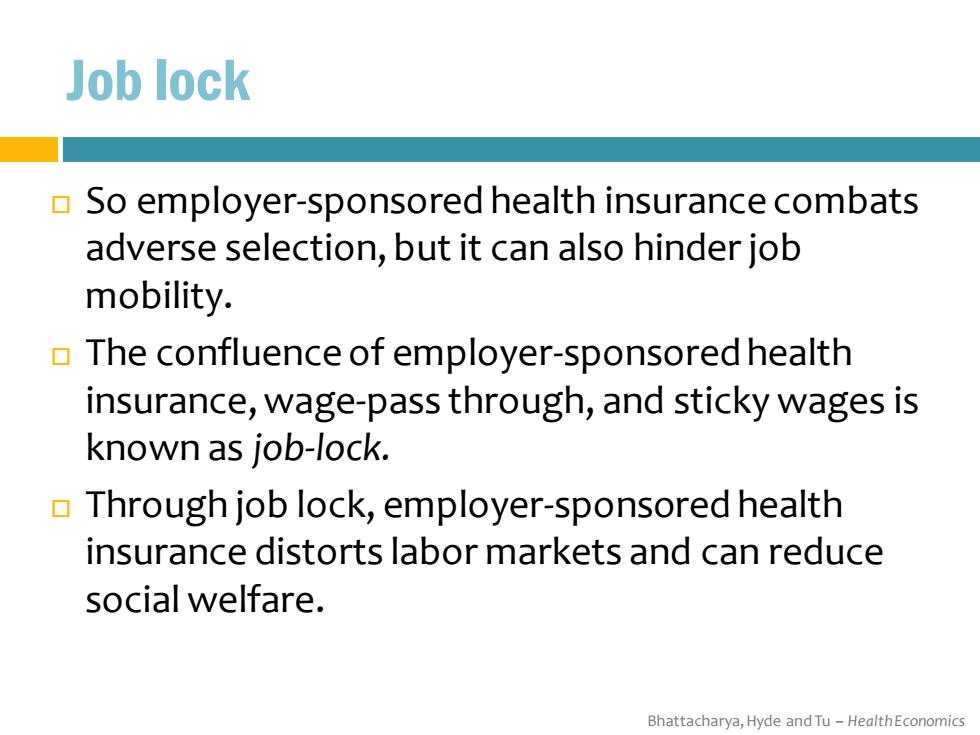
Firm-specific human capital Firm-specific human capital:knowledge and experience gained from working at a particular firm that is highly relevant there but irrelevant at other companies. Workers with firm-specific human capital can be much more productive at their firm than anywhere else. The accumulation of firm-specific human capital can mean that an employee who is invaluable to one firm would be just mediocre at another firm. If so,wages the worker earns in her current job would exceed what she could earn at another company. Bhattacharya,Hyde and Tu-HealthEconomics
Bhattacharya, Hyde and Tu – Health Economics Firm-specific human capital Firm-specific human capital: knowledge and experience gained from working at a particular firm that is highly relevant there but irrelevant at other companies. Workers with firm-specific human capital can be much more productive at their firm than anywhere else. The accumulation of firm-specific human capital can mean that an employee who is invaluable to one firm would be just mediocre at another firm. If so, wages the worker earns in her current job would exceed what she could earn at another company

Job lock So employer-sponsored health insurance combats adverse selection,but it can also hinder job mobility. The confluence of employer-sponsored health insurance,wage-pass through,and sticky wages is known as job-lock. Through job lock,employer-sponsored health insurance distorts labor markets and can reduce social welfare. Bhattacharya,Hyde and Tu-HealthEconomics
Bhattacharya, Hyde and Tu – Health Economics Job lock So employer-sponsored health insurance combats adverse selection, but it can also hinder job mobility. The confluence of employer-sponsored health insurance, wage-pass through, and sticky wages is known as job-lock. Through job lock, employer-sponsored health insurance distorts labor markets and can reduce social welfare

Job lock Example:Consider an employee who is bound to a wheelchair by multiple sclerosis(MS). Despite his higher health care costs,his wages have not been cut because of "wage pass-through"since his diagnosis(his company would have been sued). Suppose this employee would be a better fit for a new job opportunity elsewhere. However,his potential new employer,observing his wheelchair,lowers his offered wage to compensate for an anticipated rise in health care premiums. This lower offer deters the worker from switching jobs, and he stays-unhappily and inefficiently -at his current one. Bhattacharya,Hyde and Tu-HealthEconomics
Bhattacharya, Hyde and Tu – Health Economics Job lock Example: Consider an employee who is bound to a wheelchair by multiple sclerosis (MS). Despite his higher health care costs, his wages have not been cut because of “ wage pass-through” since his diagnosis (his company would have been sued). Suppose this employee would be a better fit for a new job opportunity elsewhere. However, his potential new employer, observing his wheelchair, lowers his offered wage to compensate for an anticipated rise in health care premiums. This lower offer deters the worker from switching jobs, and he stays – unhappily and inefficiently – at his current one

Job lock This worker would be more productive at a new job, so it would be socially efficient for him to switch.But job lock discourages him from doing so. While job-lock reduces voluntary employee turnover rate by 25%,the total cost of job lock in the U.S.is modest,less than 0.1%of GDP. The social loss from job lock may be this modest because of policies aimed at mitigating the harm caused by job lock. Example:The COBRA Act of 1985 Bhattacharya,Hyde and Tu-HealthEconomics
Bhattacharya, Hyde and Tu – Health Economics Job lock This worker would be more productive at a new job, so it would be socially efficient for him to switch. But job lock discourages him from doing so. While job-lock reduces voluntary employee turnover rate by 25%, the total cost of job lock in the U.S. is modest, less than 0.1% of GDP. The social loss from job lock may be this modest because of policies aimed at mitigating the harm caused by job lock. Example: The COBRA Act of 1985